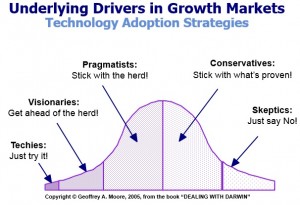 Becoming a social business and achieving the benefits associated with it from improved communication and serendipity are quite valuable in the innovation-oriented competitive situation faced by many companies. Still, this journey is a difficult one to take because of the ingrained culture in the majority of companies.
Becoming a social business and achieving the benefits associated with it from improved communication and serendipity are quite valuable in the innovation-oriented competitive situation faced by many companies. Still, this journey is a difficult one to take because of the ingrained culture in the majority of companies.
In this post, I examine the various obstacles on individual level to adopting a culture of transparency required to become a social business.
Obstacle 1: The boss knows best
While Taylorism has had a bad name for a long period of time already, it still appears in actions, even if not in name. This obstacle is typical in a hierarchical organization where the managers are not used to discussing future decisions with the rank-and-file.
It is often not the result of pure disregard of the opinions of those on the lower rungs of the hierarchy, but simply lack of understanding that they actually might know their job better than the manager does and could provide crucial contribution to any planned changes. Instead, changes are decided in cabinets and announced to employees unilaterally.
The Lean principle of going to the gemba (the place where the work is actually done) before making any decisions is an effective countermeasure to this obstacle. In a social collaboration environment, this approach can manifest through making preliminary material available and actively seeking comments and opinions.
This obstacle can be gradually overcome through positive experiences and increased understanding of the contribution each individual is able to make.
Obstacle 2: Knowledge is power for managers
Some managers may understand that others could also contribute and improve the results, but refuse to share nonetheless, often even with other managers. By keeping as much knowledge as possible hidden, they are able to protect their own position and make themselves irreplaceable. At least, so they think, and it often works at least for a period of time until the company realizes that it cannot afford to keep such people on board regardless of short-term losses.
This obstacle manifests itself through hidden decision-making and secrecy, but also through various more subtle means. Have you ever went to a meeting and have someone present material specifically prepared for that meeting there without sharing it in advance, even though it is obvious that the material was prepared well in advance (last minute bundles do not count). If the material is also somewhat controversial and would require careful study, the time for which you have just been denied by this clever ploy, you are dealing with a knowledge is power type of a manager.
The contrast to this practice is Toyota. We know a lot about work and life at Toyota from countless publications, and Toyota is willing to share many of its practices even with complete strangers. This is because Toyota realizes that true power lies in what you will be able to do tomorrow, not in what you do today. I have used this same principle throughout my working career: I can share everything I know today, because I know I will come up with many new things tomorrow, and it is this capability that is difficult or even nigh impossible to copy. Withholding knowledge for power implies uncertainty on the individual’s ability to come up with new things. Building a path of continuous learning can help here.
Obstacle 3: Knowledge is power for employees
The same obstacle appears on all levels in an organization, not only in management. It can appear on the assembly line or in service as a reluctance to share how problems can be solved or how things can be done in the most effective way. If no one knows how to do your job, that makes you irreplaceable, right?
Again, the root of the issue is a false concept of human possibilities. It is very tempting to hide knowledge if you believe that you have a specific set of knowledge and that’s it, but in fact, the human ability to learn new things is almost unlimited. Again, we come to the point where starting everyone on a path of life-long learning is the key to dissolve this obstacle.
Obstacle 4: Fear of humiliation
What if I share my ideas in public and others ridicule them or say nasty things about me? Asian cultures in particular are known for the importance of saving face, but to an extent this applies everywhere. It is not a new issue: one of W. Edwards Deming’s 14 principles was “Drive out fear” – yet most companies have still not fully succeeded in this.
I don’t think a company where everyone is nice all the time exists. People are rude or blunt at times, me included, but single instances of such behavior do not necessarily ruin everything. In fact, when people contribute on regular basis, a single bad experience among many interactions is of less significance than a single bad experience among few interactions. It is important to keep the overall atmosphere positive, encouraging, and working towards a common goal. The point of paramount importance, however, is actually making things happen when people contribute their ideas and suggestions. Nothing quite makes the point that a contribution is valued than actually implementing it.
Obstacle 5: Disengagement at work
Many people are disengaged at work. They may come in every morning at 8 am and leave at 4 pm, but life proper for them begins after that 4 pm. There can be no social business where the employees are not engaged: unless the everyone at the company sees that their job has two aspects to it – to handle daily work and to improve daily work – it is not possible to achieve great results.
In a Dale Carnegie study a couple of years ago, the researchers proposed three key drivers of employee engagement:
- Relationship with the immediate supervisor
- Senior leadership’s ability to lead the company and communicate its goals
- Organizational pride – vision of organization and corporate social responsibility
Interestingly enough, two of these three factors can be affected quite rapidly by senior management activities. Thus, while grassroots movements are all fine and good, turning a corporation to the social path has to start from the top.
Overcoming the obstacles and connection to Lean
What is particularly interesting about these obstacles to social business is that each of them is also an obstacle to implementing Lean. Therefore, companies that have fully adopted the Lean model are culturally in a great position to adopt social business as well.
This raises the question, how do you build a successful Lean program and can some of the lessons learned there be applied to building a social business as well? It all starts with top management. The top management has to be completely aligned in their pursuits, and from there it spreads throughout the organization, often over several years. As in any good PDSA cycle, the first step is grasping the current situation and the obstacles that prevent you from moving forward.
Photo: Boulders by Robb Hannawacker @ Flickr (CC)
 Change management is hard. As a general rule, change adoption rarely, if ever, happens overnight by simply adding a new process or technology and holding a few training sessions.
Change management is hard. As a general rule, change adoption rarely, if ever, happens overnight by simply adding a new process or technology and holding a few training sessions.














